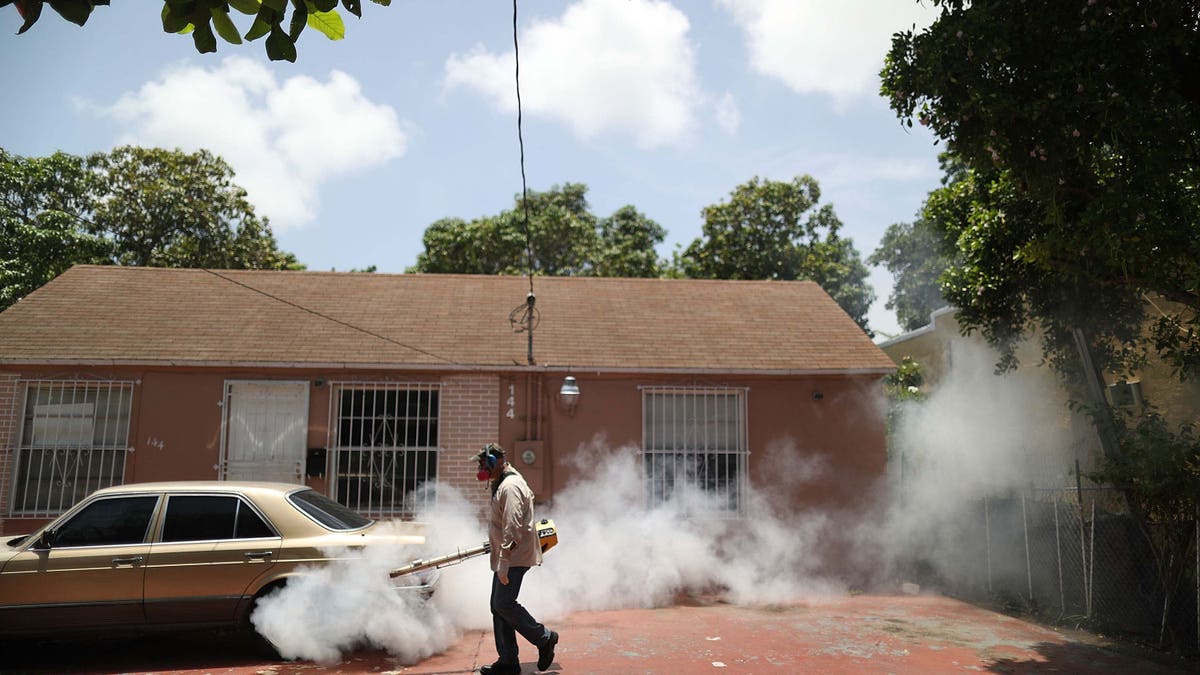Fox News Flash top headlines for September 25
Fox News Flash top headlines are here. Check out what's clicking on Foxnews.com.
New York has reported the state’s first death from Eastern equine encephalitis (EEE), a disease that spreads through bites from mosquitoes.
The patient was the first person to contract EEE in New York since 2015, according to a press release issued by the state on Monday.
"Keeping New Yorkers safe is my top priority," Governor Hochul said in a statement.
WHAT IS EEE, THE MOSQUITO-BORNE DISEASE THAT KILLED A NEW HAMPSHIRE MAN?
"Following the first confirmed human case of EEE, my administration took statewide action to help protect communities – and with today’s declaration, we’re making more state resources available to local departments to support their public health response."

New York has reported the state’s first death from Eastern equine encephalitis (EEE), a disease that spreads through bites from mosquitoes. (iStock)
"We’ve been informed this patient has passed away from EEE; we extend our sympathies and our hearts go out to their family."
State Health Commissioner Dr. James McDonald has declared EEE an imminent threat to public health, which will make more resources available for prevention measures, such as spraying to reduce mosquitoes.
NORTHEASTERN TOWNS ISSUE VOLUNTARY LOCKDOWN TO PREVENT SPREAD OF MOSQUITO-BORNE DISEASE
The state has announced plans to expand access to insect repellent in parks and campgrounds, and is encouraging New York residents to take steps to protect against mosquito-borne illness.
What is EEE?
Eastern equine encephalitis is caused by a virus that is spread through the bite of an infected mosquito, according to the Centers for Disease Control and Prevention (CDC), which describes EEE as a "rare but serious disease."
Only a few cases are reported in the U.S. each year, most in the Eastern or Gulf Coast states, the agency states on its website.

Some Northeastern towns have enacted voluntary lockdowns due to the rise in EEE cases. (iStock)
Humans and other animals that contract the virus are considered "dead-end hosts," the CDC states, which means they can’t spread it to mosquitoes that bite them.
"EEE is only spread to humans via a mosquito bite, and cannot be transmitted directly by other humans or horses," Dr. Kurt Vandock, PhD, a public health expert and VP of strategic growth for Mosquito Squad, told Fox News Digital.
The patient was the first person to contract EEE in New York since 2015.
Common symptoms of EEE include fever, vomiting, diarrhea, headache, stiff neck, seizures, behavioral changes and drowsiness.
These usually appear five to 10 days after being bitten.
"Most people have no symptoms; others get only a mild, flu-like illness with fever, headache and sore throat," Vandock said.

Using insect repellents that contain DEET can help to protect against mosquito bites, experts say. (iStock)
"For people with an infection of the central nervous system, a sudden fever (103º to 106º), severe headache and stiff neck can be followed quickly by seizures and coma."
The disease can be deadly, resulting in fatalities for 30% of infected people. It can also lead to chronic neurological deficiencies, per the CDC.
ANTHONY FAUCI’S WEST NILE VIRUS DIAGNOSIS: WHAT TO KNOW ABOUT THE MOSQUITO-BORNE DISEASE
"The best way to confirm any illness is with an approved and accurate test administered by a medical professional," said Vandock.
"Eastern equine encephalitis is a serious disease with symptoms occurring fast," he warned.
"If you live in an area with noted EEE activity and have flu-like symptoms after being bitten by a mosquito, you should seek medical care immediately."
Concerns of wider infection
In addition to New York, other states that have reported human EEE cases include Massachusetts, Vermont, New Jersey, Rhode Island, Wisconsin and New Hampshire.
"Anytime life is put at risk by vector-borne disease, we are concerned," Vandock said.
"As viral loads increase and transmission rates follow this trend, it is a sign that interventions are necessary to help reduce the risk of transmission," he went on.

Common symptoms of EEE include fever, vomiting, diarrhea, headache, stiff neck, seizures, behavioral changes and drowsiness. (iStock)
"One case of any vector-borne disease is one too many."
As far as why cases have been more prevalent in northeastern states, Vandock said there’s no simple answer.
"Conducive weather patterns, high population density, the heavy presence of the primary vector and seasonality — coinciding with increased outdoor activity — can create the perfect storm for rapid transmission," he said.
"One case of any vector-borne disease is one too many."
The black-tailed mosquito (Culiseta melanura), the primary vector of EEE, can be found in large numbers in the Northeastern United States, according to Vandock.
"It is known to feed mainly on birds, but does not typically feed on humans," he said. "As a result, the transmission of EEE to humans and horses is generally thought to occur via ‘bridge vectors,’ which contract the virus from infected birds and can then pass the virus on to other hosts."
CLICK HERE TO GET THE FOX NEWS APP
The mosquitoes that act as "bridge vectors" can be found in the Northeast areas where transmission is occurring, the expert noted.
The risk of contracting the EEE virus is highest during the summer months — especially toward the end of summer, when people go back outdoors as temperatures cool, Vandock said.

The mosquitoes that act as "bridge vectors" can be found in the Northeast areas where transmission is occurring, an expert noted. (iStock)
"Anyone who lives or works close to wetlands and swamps is also at an increased risk," he said.
The Midwest saw a similar outbreak of EEE in 2019 in Michigan, Vandock noted, as many schools canceled after-school activities after numerous fatalities from the disease.
CLICK HERE TO SIGN UP FOR OUR HEALTH NEWSLETTER
"Current trends suggest that with increasing globalization, population densities, ranges of competent hosts and a favorable climate, the occurrence of EEE and other vector-borne diseases will increase," he added.
Dr. Marc Siegel, senior medical analyst for Fox News and clinical professor of medicine at NYU Langone Medical Center, said he is not concerned by the increase in cases.
"It is still a very slight uptick, and it is confined to mosquito transmission," he told Fox News Digital, adding that he only anticipates "sparse cases" in other parts of the country.
Treatment and prevention
There is currently no vaccine for Eastern equine encephalitis, and supportive care is the only means of treating symptoms.

A mosquito control inspector sprays pesticide to kill mosquitos amid a Zika virus outbreak in Miami, Florida, in 2016. (Getty Images)
Educating the public about the risk, encouraging mosquito repellent use, and spraying to control the mosquito population are the best ways to prevent infection, according to experts.
For more Health articles, visit www.foxnews.com/health
The state of New York issued the following recommendations for prevention.
- Wear long sleeves, pants and socks when outdoors during periods of high mosquito activity, such as dusk or dawn.
- Use insect repellents that contain DEET.
- Ensure that there are screens in all windows and doors.
- Eliminate standing water in outdoor areas where mosquitoes tend to breed.


